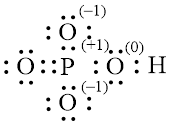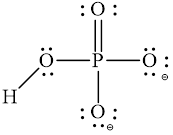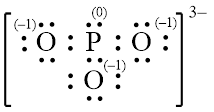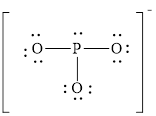
(a)
Interpretation:
The electron dot formula and structural formula of PO3−4 are to be drawn.
Concept introduction:
An electron dot formula is a way of representing the molecular structure in which electrons are represented by a dot. Structural formula is a way in which atoms are linked together through a solid line. This solid line represents the covalent bond. An electron dot structure is known as Lewis structure. Electron dot structure indicates the valence electrons of an atom which are involved in bonding.
Answer to Problem 42E
Electron dot structure and structural formula of PO3−4 are shown below.


Explanation of Solution
In molecule PO3−4 phosphorous is present as a central atom and oxygen is present as the surrounding atom of phosphorous. Phosphorous has 5 valence electrons and oxygen has 6 valence electrons. Negative charge present on the molecule indicates that three electrons are gained by the atom of the molecule. Total number of electron pairs is calculated by adding the valence electrons and the negative charge present on the molecule. So, number of electrons is (6+5+3) which is 14. Total electrons present in each bond pair is 2. Rest of the electrons are present as the lone pairs on oxygen atoms. An electron dot structure and structural formula of PO3−4 is shown below in Figure 1 and 2 respectively.

Figure 1

Figure 2
Solid line, in Figure 2, between the phosphorous and oxygen atom is the covalent bond which is made up of two electrons. This bond is formed by sharing of electrons between the atoms present in that bond.
An electron dot structure and structural formula of PO3−4 are shown above in Figure 1 and Figure 2.
(b)
Interpretation:
The electron dot formula and structural formula of HPO2−4 are to be drawn.
Concept introduction:
An electron dot formula is a way of representing the molecular structure in which electrons are represented by a dot. Structural formula is a way in which atoms are linked together through a solid line. This solid line represents the covalent bond. An electron dot structure is known as Lewis structure. Electron dot structure indicates the valence electrons of an atom which are involved in bonding.
Answer to Problem 42E
Electron dot structure and structural formula of HPO2−4 are shown below.


Explanation of Solution
In molecule HPO2−4, phosphorous is the central atom and surrounding atom of phosphorous is oxygen. Phosphorous has 5 valence electrons and oxygen has 6 valence electrons. Negative charge present on the molecule indicates that two electrons are gained by the molecule. Total number of electron pairs is calculated by adding the valence electrons and the negative charge present on the molecule. So, number of electrons is (6+6+6+6+5+1+2) which is 32. This shows that total electrons must be 32 or 16 pair of electrons. Total electrons present in each bond pair is 2. Rest of the electrons are present as the lone pair on phosphorous and oxygen atoms. An electron dot structure and structural formula of HPO2−4 is shown below in Figure 3 and 4 respectively.

Figure 3

Figure 4
Each solid line, in Figure 4, between the phosphorous and oxygen atom is the covalent bond which is made up of two electrons. This bond is formed by sharing of electrons between the central atom phosphorous and the surrounding oxygen atoms.
An electron dot structure and structural formula of HPO2−4 are shown above in Figure 3 and Figure 4.
(c)
Interpretation:
The electron dot formula and structural formula of PO3−3 are to be drawn.
Concept introduction:
An electron dot formula is a way of representing the molecular structure in which electrons are represented by a dot. Structural formula is a way in which atoms are linked together through a solid line. This solid line represents the covalent bond. An electron dot structure is known as Lewis structure. Electron dot structure indicates the valence electrons of an atom which are involved in bonding.
Answer to Problem 42E
Electron dot structure and structural formula of PO3−3 are shown below.


Explanation of Solution
In molecule PO3−3, phosphorous is the central atom and surrounding atom of phosphorous is oxygen. Phosphorous has 5 valence electrons and oxygen has 6 valence electrons. Negative charge present on the molecule indicates that three electrons are gained by the the molecule. Total number of electron pairs is calculated by adding the valence electrons and the negative charge present on the molecule. So, number of electrons is (6+6+6+5+3) which is 26. This shows that total electrons must be 26 or 13 pair of electrons. Total electrons present in each bond pair is 2. Rest of the electrons are present as the lone pair on phosphorous and oxygen atoms. An electron dot structure and structural formula of PO3−3 is shown below in Figure 5 and 6 respectively.

Figure 5

Figure 6
Each solid line, in Figure 6, between the phosphorous and oxygen atom is the covalent bond which is made up of two electrons. This bond is formed by sharing of electrons between the central atom and the surrounding atom.
An electron dot structure and structural formula of PO3−3 are shown above in Figure 5 and Figure 6.
(d)
Interpretation:
The electron dot formula and structural formula of HPO2−3 are to be drawn.
Concept introduction:
An electron dot formula is a way of representing the molecular structure in which electrons are represented by a dot. Structural formula is a way in which atoms are linked together through a solid line. This solid line represents the covalent bond. An electron dot structure is known as Lewis structure. Electron dot structure indicates the valence electrons of an atom which are involved in bonding.
Answer to Problem 42E
Electron dot structure and structural formula of HPO2−3 are shown below.
![]()

Explanation of Solution
In molecule HPO2−3, phosphorous is the central atom and surrounding atom of phosphorous is oxygen. Phosphorous has 5 valence electrons and oxygen has 6 valence electrons. Negative charge present on the molecule indicates that two electrons are gained by the molecule. Total number of electron pairs is calculated by adding the valence electrons and the negative charge present on the molecule. So, number of electrons is (6+6+6+5+2+1) which is 28. This shows that total electrons must be 28 or 14 pair of electrons. Total electrons present in each bond pair is 2. Rest of the electrons are present as the lone pair on phosphorous and oxygen atoms. An electron dot structure and structural formula of HPO2−3 is shown below in Figure 7 and 8 respectively.
![]()
Figure 7

Figure 8
Each solid line, in Figure 8, between the phosphorous and oxygen atom is the covalent bond which is made up of two electrons. This bond is formed by sharing of electrons between the central atom and the surrounding atom.
An electron dot structure and structural formula of HPO2−3 are shown above in Figure 7 and Figure 8.
Want to see more full solutions like this?
Chapter 12 Solutions
Introductory Chemistry: Concepts and Critical Thinking (8th Edition)
- Can you explain how I get these here and show the steps plz?arrow_forwardGive the IUPAC name for this compound Hydrocarbon Condensed Formulas Hint C2H5 CH2CH3 expand that in all the formula Part A: (CH3)2CHCH(C2H5)CH2CH2CH3 Give the IUPAC name for this compound. Part B: CH2=C(C2H5)CH2CH2CH3 Give the IUPAC name for this compound. Part C: (CH3)2C=CHC(C2H5)=CH2 Give the IUPAC name for this compound. Part D: CH3C=CCH(C2H5)2 Give the IUPAC name for this compound. Part E: (CH3)3CC=CCH2CH=C(CH3)2arrow_forwardSelect/ Match the correct letter from the image below for the IUPAC names given below: A B C D 3 E F G H K L Part 1. 4-methylheptane For example.mmmm Answer Letter H _for part 1 Part 2. 2,4-dimethylhexane Part 3. 2,3-dimethylpentane Part 4. 2,2-dimethylhexane Part 5. 2-ethyl-1,1,3,3-tetramethylcyclopentane Part 6. 3-ethyl-2-methylpentanearrow_forward
- Can u show the process as to how to get these?arrow_forwardSketch the expected 'H NMR spectra for the following compound. Label all of the H's in the structure and the corresponding signal for the spectra you sketch. Make sure you include the integration value and the splitting pattern for each signal Indicate how many signals you would expect in the 13C NMRarrow_forwardUse IUPAC naming rules to name the following hydrocarbon compounds: CH2-CH3 | a) CH-CH-CH2-CH-CH-CH3 b) | CH2 CH3 | CH3 CH3 \ / C=C H 1 H CH2-CH3 c) d) CH=C-CH3 e) CH3-CH2-CH2-CH=CH-CH3 f) CH2=CH-CH2-CH=CH-CH3 g) CH3-CH2-C = C-CH2-CH3 h)arrow_forward
- Q5 Name the following : a. b. C. d. e.arrow_forward25. Predict the major product of the following reaction. 1 equivalent of each of the starting materials was used. H₂C CH3 CH3 H3C H3C H3C. CH2 + H3C. heat CH3 CH H.C. CH3 H.C H.C CH3 CH CH3 CH3 A B C Earrow_forwardFind chemical structures based on the below information. a) Chemical formula C6H8O Compound is aromatic plus has two 1H NMR peaks that integrated for 3 each that are singlets (it could have more peaks in the 1H NMR b) Chemical Formula: C6H100 Compounds is conjugated 'H NMR has a signal that integrates for 6 and is a doublet IR spectra has a signal at 1730 cm-1arrow_forward
- Jaslev Propose a synthesis of the following starting from benzene and any other reagents and chemicals. No mechanisms are required. Indicate the condition for each step plus the major product for each step. More than two steps are required. Step 1 Step 2 مہد Brarrow_forwardPart C: The line formula for another branched alkane is shown below. i. In the IUPAC system what is the root or base name of this compound? ii. How many alkyl substituents are attached to the longest chain? iii. Give the IUPAC name for this compound.arrow_forwardPart D: Draw the Structural Formula for 4-ethyl-2-methylhexane Part E. Draw the Structural Formula for 1-chloro-3,3-diethylpentane (Chloro = Cl)arrow_forward
 ChemistryChemistryISBN:9781305957404Author:Steven S. Zumdahl, Susan A. Zumdahl, Donald J. DeCostePublisher:Cengage Learning
ChemistryChemistryISBN:9781305957404Author:Steven S. Zumdahl, Susan A. Zumdahl, Donald J. DeCostePublisher:Cengage Learning ChemistryChemistryISBN:9781259911156Author:Raymond Chang Dr., Jason Overby ProfessorPublisher:McGraw-Hill Education
ChemistryChemistryISBN:9781259911156Author:Raymond Chang Dr., Jason Overby ProfessorPublisher:McGraw-Hill Education Principles of Instrumental AnalysisChemistryISBN:9781305577213Author:Douglas A. Skoog, F. James Holler, Stanley R. CrouchPublisher:Cengage Learning
Principles of Instrumental AnalysisChemistryISBN:9781305577213Author:Douglas A. Skoog, F. James Holler, Stanley R. CrouchPublisher:Cengage Learning Organic ChemistryChemistryISBN:9780078021558Author:Janice Gorzynski Smith Dr.Publisher:McGraw-Hill Education
Organic ChemistryChemistryISBN:9780078021558Author:Janice Gorzynski Smith Dr.Publisher:McGraw-Hill Education Chemistry: Principles and ReactionsChemistryISBN:9781305079373Author:William L. Masterton, Cecile N. HurleyPublisher:Cengage Learning
Chemistry: Principles and ReactionsChemistryISBN:9781305079373Author:William L. Masterton, Cecile N. HurleyPublisher:Cengage Learning Elementary Principles of Chemical Processes, Bind...ChemistryISBN:9781118431221Author:Richard M. Felder, Ronald W. Rousseau, Lisa G. BullardPublisher:WILEY
Elementary Principles of Chemical Processes, Bind...ChemistryISBN:9781118431221Author:Richard M. Felder, Ronald W. Rousseau, Lisa G. BullardPublisher:WILEY





